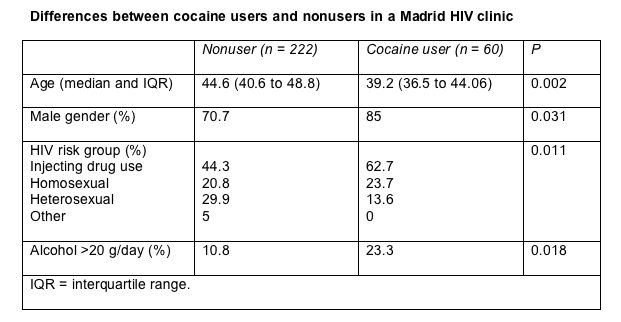 |
 |
 |
| |
Cocaine Boosts Cardiovascular Risk in Spanish Patients With HIV
|
| |
| |
11th European AIDS Conference
October 24-27, 2007
Madrid
Mark Mascolini
Counting cocaine use as a cardiovascular risk factor in people with HIV raised the proportion of patients with two or more heart risk factors from 33% to 42%, Madrid clinicians reported at the 11th European AIDS Conference [1]. Two thirds of the 282 people studied used cocaine at least once, and 1 in 5 used cocaine consistently over the past year. Investigators from the Gregorio Maranon University Hospital blame cocaine and tobacco for the high cardiovascular risk in their patients and urge colleagues to help patients stop using both drugs.
Teresa Fernandez and colleagues used the Framingham score to estimate cardiovascular risk in 282 consecutive patients attending their clinic. No one had a personal history of ischemic heart disease, incidence of which climbed from 0.49 to 1.29 cases per 1000 person-years at this same Madrid clinic from 1988 to 2005 (P < 0.05) [2]. The researchers considered "cocaine use" as consistent use over the past year, which 60 study participants (21.3%) reported. All told, 190 people (67.4%) tried cocaine at least once, 26 (9.2%) used the drug in the past month, and 10 (3.5%) took cocaine in the past week.
The cohort included 135 people (47.9%) who acquired HIV through injecting drugs, 60 (21.3%) who picked up HIV through sex between men, and 74 (26.2%) who became infected during heterosexual sex. Most study participants (85%) smoked tobacco, puffing their way through a median of 20 cigarettes daily. Other classic cardiovascular risk factors were diabetes in 5%, hypertension in 7.4%, body mass index above 30 kg/m2 in 6.5%, family history of heart disease in 12.1%, high-density lipoprotein cholesterol below 40 mg/dL in 21.7%, and low-density lipoprotein cholesterol above 160 mg/dL in 9.4%.
One third of these people had two or more classic heart risk factors, while 63.9% had one such risk factor. The study group had a median of 1 risk factor (range 0 to 4), and the median 10-year risk score measured 5% (interquartile range 3% to 9%). If Fernandez counted cocaine use as a cardiovascular risk factor, the proportion of people with two or more factors rose from 33.1% to 41.7%.
Younger age, male gender, injecting drug use, and drinking more than 20 grams of alcohol daily proved significantly more common in the 60 people who used cocaine over the past 12 months than in those who did not (Table). Cocaine use did not correlate with CDC disease category, CD4 count, antiretroviral use, cigarette smoking, or lipid abnormalities.

Cigarette smoking remains endemic in Europe, as anyone caught in the nicotine cloud at this HIV meeting knows. Cocaine use apparently inflates an already high heart risk score in many HIV-infected Europeans, especially those infected by sharing injecting equipment.
US researchers have proposed that HIV and cocaine may work hand-in-hand to hamper cardiac function, perhaps by enhancing adrenergic stimulation [3]. Cocaine alone magnified cardiac mass and mortality in a mouse model of AIDS [4].
"To reduce the risk of ischemic cardiomyopathy in our population," Fernandez and coworkers conclude, "special attention should be paid to reduce the use of both drugs."
References
1. Fernandez T, Sanchez-Conde M, Cosin J, et al. Cocaine as a new cardiovascular risk factor in HIV-infected population. 11th European AIDS Conference. October 24-27, 2007. Madrid. Abstract P9.5/07.
2. Lopez JC, Sanchez-Conde M, Lopez-Gay D, et al. Incidence of ischemic cardiomyopathy is increasing in HIV-infected patients in Madrid. 11th European AIDS Conference. October 24-27, 2007. Madrid. Abstract P9.5/08.
3. Soodini G, Morgan JP. Can cocaine abuse exacerbate the cardiac toxicity of human immunodeficiency virus? Clin Cardiol. 2001;24:177-181.
4. Sutliff RL, Haase C, Russ R, et al. Cocaine increases mortality and cardiac mass in a murine transgenic model of acquired immune deficiency syndrome. Lab Invest. 2003;83:983-989.
|
| |
|
 |
 |
|
|